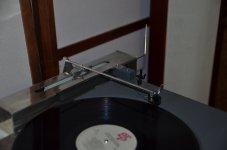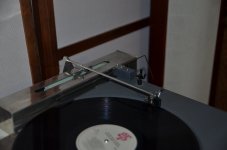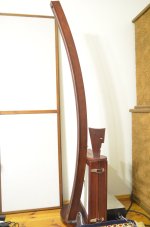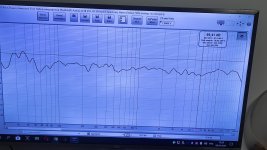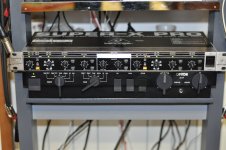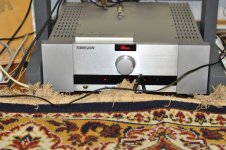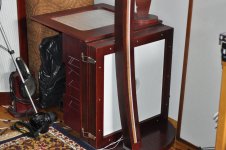https://drive.google.com/file/d/1wIHkHwIsaQXD8q5QDU12RR6p9bZfLaLo/view?usp=sharing
Recording on the microphone of this turntable. Larry Carlton, guitar.
Recording on the microphone of this turntable. Larry Carlton, guitar.
Enjoying your work!
I am currently looking at crossovers. Is your Behringer Super-X pro crossover "good enough" for your revealing speakers? My dbx Driverack PA2 has great features but is a digital crossover and does not seem to sound as clean and transparent as my old Bryston 10B-std analogue crossover (which needs an expensive rebuild).
I am currently looking at crossovers. Is your Behringer Super-X pro crossover "good enough" for your revealing speakers? My dbx Driverack PA2 has great features but is a digital crossover and does not seem to sound as clean and transparent as my old Bryston 10B-std analogue crossover (which needs an expensive rebuild).
At first I was engaged in equalization, it was necessary to clean up a few parasitic peaks in the frequency response.
I bought an analog equalizer, but there weren’t those frequencies that needed to be strangled (conditionally 67Hz, 136Hz, 234Hz), these peaks were quite sharp and almost did not touch neighboring frequencies.
Therefore, I bought a fairly cheap parametric equalizer, mastered it in two evenings, I liked it.
But then I thought, why not buy a crossover from the same company, I liked the design))), so I bought it, tried to set it up, the 600Hz band section seemed to me the most effective.
I looked at your version on Google, it is more versatile, it has a lot of sound processing components, it never occurred to me to buy one right away, so my path was phased))).
You write that the sound was brighter in an analog crossover, for some time now I have revised these concepts, as well as the selection of cables, speaker stands, and so on.
For me, it seemed much more important to correctly set up the speakers in the room, well, the very quality and potential of the speakers, I believe that all the main distortions are located in this area and these distortions are very, very large, so I focused on them, but not on selection of less important components that play a less important role in the sound.
Roughly speaking, the correct equalization of the final sound coming out of the speakers can level out what we are trying to do with different components, including cables, plugs and other trifles, because in modern audio there are not even timbre blocks, as it was in the Hi-fi components of the time, modern amplifiers do not even have high and low frequencies, so we have to sort through different cables or speaker stands, as well as look for which crossovers give a clearer or darker sound.
This is my subjective opinion, IMHO.
In this sense, I decided to experiment on myself and I liked the result, although earlier I actively selected different amplifiers, voltage stabilizers, cables ... I was looking for a clearer sound in them when it was required or darker, now I just need to touch the equalizer and !-oh miracle, get a clearer sound if you want it😆.
I bought an analog equalizer, but there weren’t those frequencies that needed to be strangled (conditionally 67Hz, 136Hz, 234Hz), these peaks were quite sharp and almost did not touch neighboring frequencies.
Therefore, I bought a fairly cheap parametric equalizer, mastered it in two evenings, I liked it.
But then I thought, why not buy a crossover from the same company, I liked the design))), so I bought it, tried to set it up, the 600Hz band section seemed to me the most effective.
I looked at your version on Google, it is more versatile, it has a lot of sound processing components, it never occurred to me to buy one right away, so my path was phased))).
You write that the sound was brighter in an analog crossover, for some time now I have revised these concepts, as well as the selection of cables, speaker stands, and so on.
For me, it seemed much more important to correctly set up the speakers in the room, well, the very quality and potential of the speakers, I believe that all the main distortions are located in this area and these distortions are very, very large, so I focused on them, but not on selection of less important components that play a less important role in the sound.
Roughly speaking, the correct equalization of the final sound coming out of the speakers can level out what we are trying to do with different components, including cables, plugs and other trifles, because in modern audio there are not even timbre blocks, as it was in the Hi-fi components of the time, modern amplifiers do not even have high and low frequencies, so we have to sort through different cables or speaker stands, as well as look for which crossovers give a clearer or darker sound.
This is my subjective opinion, IMHO.
In this sense, I decided to experiment on myself and I liked the result, although earlier I actively selected different amplifiers, voltage stabilizers, cables ... I was looking for a clearer sound in them when it was required or darker, now I just need to touch the equalizer and !-oh miracle, get a clearer sound if you want it😆.
"the correct equalization of the final sound coming out of the speakers can level out what we are trying to do with different components, including cables, plugs and other trifles"
Using the versatile driverack dsp, I do agree startling adjustments in frequency response, tone, and room response can be made, way more than things like cables. On the other hand, my ears suspect that as amount of dsp increases, the more I lose in terms of fine subtlety, delicacy, and freshness of the signal. I wonder if very expensive, TOTL dsp avoids this effect, or very high quality analogue crossover (and/or eq) is the way to go.
Using the versatile driverack dsp, I do agree startling adjustments in frequency response, tone, and room response can be made, way more than things like cables. On the other hand, my ears suspect that as amount of dsp increases, the more I lose in terms of fine subtlety, delicacy, and freshness of the signal. I wonder if very expensive, TOTL dsp avoids this effect, or very high quality analogue crossover (and/or eq) is the way to go.
There are a lot of contradictions here, if you are talking about a full analog path, then maybe it matters which processors stand in the way of analog sound. But it must be a really analog recording, respectively, a player, and so on.
But in my case, when I listen to an analog sound source (vinyl), and it passes through digital components, then all the same, in the end, the difference is very large between the analog sound source and digital, yes, there is a contradiction in this.
But I continue to insist that the biggest change in sound quality for the worse occurs in the speaker-room connection.
Here, of course, you can look for some subtleties in the sound of an analog equalizer or a crossover and a digital one, but this will seem like a drop in the ocean compared to the colossal difference in the sound of two different acoustic systems and their coordination with the room.
But in my case, when I listen to an analog sound source (vinyl), and it passes through digital components, then all the same, in the end, the difference is very large between the analog sound source and digital, yes, there is a contradiction in this.
But I continue to insist that the biggest change in sound quality for the worse occurs in the speaker-room connection.
Here, of course, you can look for some subtleties in the sound of an analog equalizer or a crossover and a digital one, but this will seem like a drop in the ocean compared to the colossal difference in the sound of two different acoustic systems and their coordination with the room.
So you have something unique.
Have you tried ARTA for measurements like SPL + harmonics, IMD, polars?
https://www.artalabs.hr/
Have you tried ARTA for measurements like SPL + harmonics, IMD, polars?
https://www.artalabs.hr/
At the beginning of the topic I wrote why I made a vertical arc with a radius of 3 meters.aah its a reversed arc, never seen it like that, but looks nice, nice FR as well !
So that the signal from the entire arc, from the bottom to the top, came to the listener at the same time, because the listener is placed three meters from the radiator.
This greatly increases the sensitivity of the radiator, several times over.
And also the signal is very accurate, there is no interference "mush".
I can't stop yet, I recently bought a Kanton preamplifier, I like it very much.
So much so that I even removed the digital equalizer from my rack.
I also went back to my huge Tonevin amplifier, which is a Chinese hybrid high end amplifier.
It works in class "A" up to 30 watts, and then it automatically switches to class "A+B".
I was not satisfied with the sound of the high-frequency driver in class "D", a little unnatural sound and there is a very big peak at 12kHz.
With the Tonevin everything is smooth and even.
And I excluded the equalizer from the rack also because I acoustically shaped the low-frequency link, the main accent in it were two old synthetic blankets, and not even this is the most important, but the fact that I put them in plastic bags and closed tightly, as a result they turned out to be two bubbles filled with air and synthetic.
I strongly recommend that you do it and post the result here to make sure that works not only me🙂.
And yes, my crossover turned out to be analog, I was wrong to call it digital.
So much so that I even removed the digital equalizer from my rack.
I also went back to my huge Tonevin amplifier, which is a Chinese hybrid high end amplifier.
It works in class "A" up to 30 watts, and then it automatically switches to class "A+B".
I was not satisfied with the sound of the high-frequency driver in class "D", a little unnatural sound and there is a very big peak at 12kHz.
With the Tonevin everything is smooth and even.
And I excluded the equalizer from the rack also because I acoustically shaped the low-frequency link, the main accent in it were two old synthetic blankets, and not even this is the most important, but the fact that I put them in plastic bags and closed tightly, as a result they turned out to be two bubbles filled with air and synthetic.
I strongly recommend that you do it and post the result here to make sure that works not only me🙂.
And yes, my crossover turned out to be analog, I was wrong to call it digital.
Attachments
Hi Havun, nice project!
As your bend units focus on 3 meter, do you also not get interference patterns when not in the sweet spot? Did you do measurements at other distances/to left or right?
>Once visiting this forum, I posted a photo of my ESL where horizontally bent panels a la Martin Logan appeared and I was criticized by several people for this that allegedly these panels emit an incorrect high-frequency signal and at the same time the temporal characteristics are violated, that is, an interference porridge is obtained
As your bend units focus on 3 meter, do you also not get interference patterns when not in the sweet spot? Did you do measurements at other distances/to left or right?
Hi, I've written about it here before. The high-frequency transducers in the horizontal region are 20mm, which is the wavelength of a 17kHz sound wave, meaning that all frequencies up to 17kHz are NOT directional, but broadly directional.
In other words, in the horizontal plane, where we have a stereo effect, you can move to the right and left, and there will be no lack of high frequencies or interference.
But in the vertical plane there is sound directivity, because the tape (190cm) is bent in an arc with a radius of 3 meters.
Its defect is that it is adjusted only to the location of the head of the listener sitting on the couch, if you stand tall, then partially high frequencies fall out of focus.
But it also has the advantage that the high frequencies are NOT reflected from the floor and ceiling forming an interference, and are delivered to the listener accurate and even, without time delay.Actually the same happens with horn radiators.
The second advantage is increasing the sensitivity of high frequencies and here we must remember that electrostatic radiators make such large size to increase the sensitivity, and high-frequency radiator should NOT be large, otherwise there will be frequency interference, because the same huge area will emit high frequencies and they will come to our ear at different times, forming in the sound of interference mush.
For this reason in the standard version a high-frequency squeaker (for example a dome) has a size of 1 inch (2.5 cm), this is the wavelength of the sound at 16kHz.
But since the stereo format works only in the horizontal plane, this size (2 cm) interests us only in the horizontal plane, so all arrays in stereo build only in the vertical plane, but no one does it in the horizontal plane.
In other words, in the horizontal plane, where we have a stereo effect, you can move to the right and left, and there will be no lack of high frequencies or interference.
But in the vertical plane there is sound directivity, because the tape (190cm) is bent in an arc with a radius of 3 meters.
Its defect is that it is adjusted only to the location of the head of the listener sitting on the couch, if you stand tall, then partially high frequencies fall out of focus.
But it also has the advantage that the high frequencies are NOT reflected from the floor and ceiling forming an interference, and are delivered to the listener accurate and even, without time delay.Actually the same happens with horn radiators.
The second advantage is increasing the sensitivity of high frequencies and here we must remember that electrostatic radiators make such large size to increase the sensitivity, and high-frequency radiator should NOT be large, otherwise there will be frequency interference, because the same huge area will emit high frequencies and they will come to our ear at different times, forming in the sound of interference mush.
For this reason in the standard version a high-frequency squeaker (for example a dome) has a size of 1 inch (2.5 cm), this is the wavelength of the sound at 16kHz.
But since the stereo format works only in the horizontal plane, this size (2 cm) interests us only in the horizontal plane, so all arrays in stereo build only in the vertical plane, but no one does it in the horizontal plane.
- Home
- Loudspeakers
- Planars & Exotics
- Full-range, two-way ESL
